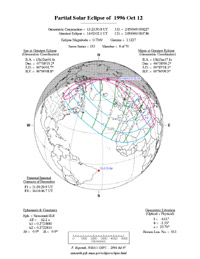Fig (1)
The eclipse stages of the 12 October 1996 partial solar eclipse.

Photo by: Aymen Ibrahem.
On 12 October 1996, a partial-only solar eclipse was visible in the Northern Hemisphere. The lunar umbra missed the Earth, but the lunar penumbra swept a large area extending from near the North Pole to the middle of the African Sahara. The eclipse was visible in Egypt, and began about an hour before sunset; actually the Sun set eclipsed for Egypt on that day!
Map (1)
The visibility of the partial-only solar eclipse of 12 October 1996

Courtesy: Fred Espenak, NASA's GSFC.
This was my first experience observing solar eclipses. Then I was working with a public observatory in Cairo, Egypt, where I was teaching amateur astronomy and giving observing sessions to the public through the observatory's three main telescopes.
To me, the year 1996, was eventful and extremely exciting as I enjoyed photographing the full stages of the two spectacular total lunar eclipses of 4 April 96 and 27 September 96, and tracked at night the bright comet Hayakutake (technically known as C/1996 B2) through its wonderful apparition in March and April of that year. This comet passed very close to Earth on its way to perihelion (the nearest point to the Sun along the comet's orbit).
On the eclipse day, I prepared my equipment long before the first contact. The visual conditions were good. I adapted my camera to the observatory's 3-inch refractor telescope shortly before the eclipse began, and I used a solar filter to protect my eyes and my equipment. The Sun looked orange-yellow through the filter against the dark background.
When the eclipse began, I experienced one of the most thrilling moments in my life: I saw, for the first time in my life, the dark New Moon taking a small bite out of the Sun. With much thrill and happiness, I looked through the telescope again.
I soon began photographing the eclipse stages. I took a photo about every 5 minutes. I worked very cautiously and I never looked directly at the Sun; I even did not stare at the filtered image of the Sun. I rather made brief visual observations of the eclipse lasting only 4-5 seconds each. I never used the finderscope of the telescope; I kept it locked throughout the observations.
I brought one of my telescopes with me. It was a small refractor. I also observed the eclipse by projecting the image of the Sun through this telescope onto a white sheet of paper. Some of the amateur astronomers I was supervising also were there to watch the eclipse, and they tracked the projected solar image.
Scattered clouds began to appear close the southwestern horizon about 30 minutes after the beginning of the eclipse. The clouds drifted near the eclipsed Sun, giving rise to another admirable natural sight: crepuscular rays. I immediately took several photos of the crepuscular rays emanating from the Sun.
Unfortunately, however, about 45 minutes after the first contact, the Sun drew closer to the horizon, and disappeared behind distant high buildings. I missed photographing the setting eclipsed Sun because of these buildings, but the photos of the eclipse stages and the crepuscular rays were very satisfactory!
Further Reading
Partial Solar Eclipse 12 October 1996
http://solareclipsewebpages.users.btopenworld.com/SECalendar_files/19961012.html
Live Images of the Eclipse
"http://www.popastro.com/eclipse/partial.htm "
Aymen Mohamed Ibrahem
PSC, senior astronomy specialist |

